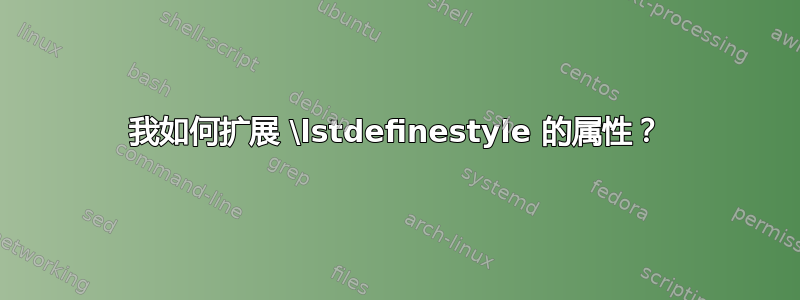
我正在将多个 Python 脚本导入我的 tex 文件。我之前有一个巨大的\lstdefinestyle定义包括了我所有脚本中所有特定函数、变量等的选项。但是,我想将其拆分开来,因为我知道你可以组合多个\lstdefinestyle调用。我的目标是有一个基本风格vscode_py它包含所有“基本”定义,然后有单独的\lstdefinestyle调用每个导入的脚本,其中包含脚本特定的变量和函数。我认为我可以通过添加更多选项来实现这一点强调风格 = [#]在单独的调用中。不幸的是,我的输出不使用任何特定于脚本的颜色定义。最后,如果这不是最好的方法,那是什么,为什么?提前致谢!
\documentclass[answers]{exam}
\usepackage[top=20mm, left=15mm, right=15mm]{geometry}
\usepackage{multicol}
\usepackage{pgfplots}
\pgfplotsset{compat=newest}
\usepackage{listings}
\definecolor{mygreen}{RGB}{28,172,0}
% the following are for VSCODE
\definecolor{black}{cmyk}{0,0,0,1}
\definecolor{darkgrey}{cmyk}{0,0,0,0.97} % background
\definecolor{green}{cmyk}{0.4,0,0.8,0.2} % comments
\definecolor{blue}{cmyk}{0.65,0.33,0,0.05} % keywords
\definecolor{rose}{cmyk}{0,0.26,0.38,0} % strings
\definecolor{lavender}{cmyk}{0,0.42,0,0.1} % conditionals
\definecolor{lightblue}{cmyk}{0.35,0,0,0} % local variables
\definecolor{aqua}{cmyk}{0.65,0,0.23,0} % class types
\lstdefinestyle{vscode_py}{
showstringspaces = false,
basicstyle = \ttfamily\footnotesize\color{white},
frame = single,
numbers = left,
numberstyle = \tiny\color{black},
xleftmargin = 7pt,
xrightmargin = 5pt,
backgroundcolor = \color{darkgrey},
commentstyle = \color{green},
stringstyle = \color{rose},
keywordstyle = [1]\color{blue},
keywordstyle = [2]\color{yellow!40},
morekeywords = [2]{__init__,
write, append, insert, concatenate,
array, linspace, arange, quiver, plot, subplot, legend},
emphstyle = [1]\color{lavender},
emph = [1]{if, else, for, in,
with, continue, return,
import, from, as},
emphstyle = [2]\color{lightblue},
emph = [2]{__name__},
emphstyle = [3]\color{aqua},
emph = [3]{numpy, np, matplotlib, pyplot, plt,
range, int, list, linalg}
}
\lstdefinestyle{first_style}{
emphstyle = [2]\color{lightblue},
emph = [2]{
A, U, S, Vh, T, AX, AY, Circ,
t, x, y, cos, sin, pi,
ax1, ax2, w1, w2, xlim, ylim,
color, angles, scale_units, scale
},
style = vscode_py
}
\lstdefinestyle{second_style}{
emphstyle = [2]\color{lightblue},
emph = [2]{A, A1, S, U, V, n2},
style = vscode_py
}
%==========================================================
\begin{document}
\begin{multicols}{2}
\lstinputlisting[
language = Python, style = first_style,
firstline = 4, lastline = 28,
firstnumber = 1,
breaklines = true
]{./unit_sphere_image.py}
\end{multicols}
\lstinputlisting[
language = Python, style = second_style,
firstline = 7, lastline = 8,
firstnumber = 1,
breaklines = true
]{./closest_matrix.py}
\end{document}
Python 文件如下:
单位球体图像.py
import numpy as np
from matplotlib import pyplot as plt
A = np.array([[1,2],[0,2]])
U, S, Vh = np.linalg.svd(A)
V = Vh.T
t = np.arange(0, 2*np.pi, 0.01)
x = np.cos(t)
y = np.sin(t)
ax1 = plt.subplot(1,2,1, xlim=(-2,2), ylim=(-2,2))
ax1.plot(x, y, 'c')
ax1.quiver(*V[:,0], color='r', angles='xy', scale_units='xy', scale=1)
ax1.quiver(*V[:,1], color='b', angles='xy', scale_units='xy', scale=1)
ax1.legend(labels=['B', r'$v_1$', r'$v_2$'])
Circ = np.array([x,y])
AX = A[0].dot(Circ)
AY = A[1].dot(Circ)
w1 = S[0]*U[:,0]
w2 = S[1]*U[:,1]
ax2 = plt.subplot(1,2,2)
ax2.plot(AX, AY, 'c')
ax2.quiver(*w1, color='r', angles='xy', scale_units='xy', scale=1)
ax2.quiver(*w2, color='b', angles='xy', scale_units='xy', scale=1)
ax2.legend(labels=['AB', r'$\phi_1 u_1$', r'$\phi_2 u_2$'])
plt.savefig('unit_sphere_image.png')
最近矩阵.py
import numpy as np
A = np.array([[1,2],[0,2]])
U, S, Vh = np.linalg.svd(A)
V = Vh.T
A1 = S[0] * U[:,0].reshape(2,1) @ V[:,0].reshape(1,2)
n2 = np.linalg.norm(A - A1, ord=2)
print(A1, n2)
答案1
问题是,当您emph在 中调用键时first_style,您会从 覆盖其值vscode_py。要添加关键字,请使用moreemph键。请参阅listings更多解释。此外,您需要vscode_py先加载样式,以便其对的调用emph不会覆盖您对的调用moreemph。
\documentclass[answers]{exam}
\usepackage[top=20mm, left=15mm, right=15mm]{geometry}
\usepackage{multicol}
\usepackage{pgfplots}
\pgfplotsset{compat=newest}
\usepackage{listings}
\definecolor{mygreen}{RGB}{28,172,0}
% the following are for VSCODE
\definecolor{black}{cmyk}{0,0,0,1}
\definecolor{darkgrey}{cmyk}{0,0,0,0.97} % background
\definecolor{green}{cmyk}{0.4,0,0.8,0.2} % comments
\definecolor{blue}{cmyk}{0.65,0.33,0,0.05} % keywords
\definecolor{rose}{cmyk}{0,0.26,0.38,0} % strings
\definecolor{lavender}{cmyk}{0,0.42,0,0.1} % conditionals
\definecolor{lightblue}{cmyk}{0.35,0,0,0} % local variables
\definecolor{aqua}{cmyk}{0.65,0,0.23,0} % class types
\lstdefinestyle{vscode_py}{
showstringspaces = false,
basicstyle = \ttfamily\footnotesize\color{white},
frame = single,
numbers = left,
numberstyle = \tiny\color{black},
xleftmargin = 7pt,
xrightmargin = 5pt,
backgroundcolor = \color{darkgrey},
commentstyle = \color{green},
stringstyle = \color{rose},
keywordstyle = [1]\color{blue},
keywordstyle = [2]\color{yellow!40},
morekeywords = [2]{__init__,
write, append, insert, concatenate,
array, linspace, arange, quiver, plot, subplot, legend},
emphstyle = [1]\color{lavender},
emph = [1]{if, else, for, in,
with, continue, return,
import, from, as},
emphstyle = [2]\color{lightblue},
emph = [2]{__name__},
emphstyle = [3]\color{aqua},
emph = [3]{numpy, np, matplotlib, pyplot, plt,
range, int, list, linalg}
}
\lstdefinestyle{first_style}{
style = vscode_py,
emphstyle = [2]\color{lightblue},
moreemph = [2]{
A, U, S, Vh, T, AX, AY, Circ,
t, x, y, cos, sin, pi,
ax1, ax2, w1, w2, xlim, ylim,
color, angles, scale_units, scale
}
}
\lstdefinestyle{second_style}{
style = vscode_py,
emphstyle = [2]\color{lightblue},
moreemph = [2]{A, A1, S, U, V, n2},
}
%==========================================================
\begin{document}
\begin{multicols}{2}
\lstinputlisting[
language = Python, style = first_style,
firstline = 4, lastline = 28,
firstnumber = 1,
breaklines = true
]{./unit_sphere_image.py}
\end{multicols}
\lstinputlisting[
language = Python, style = second_style,
firstline = 7, lastline = 8,
firstnumber = 1,
breaklines = true
]{./closest_matrix.py}
\end{document}



